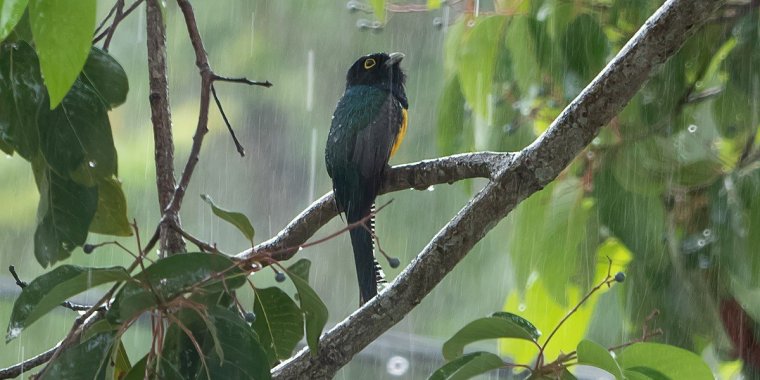| News / Science News |
Importance of rainfall for tropical animals
Imagine a tropical forest, and you might conjure up tall trees hung with vines, brightly colored birds, howling monkeys and ... rain. Indeed, precipitation patterns, along with temperature, dictate where tropical forests are distributed around the world, but surprisingly, scientists know little about the direct effects of rainfall on animals.

Male violaceous trogon bird in a rainstorm in Costa Rica. Photo: Cristian Bonilla Poveda
A new conceptual framework, developed by University of Illinois and Kansas State University researchers, calls for the scientific community to formally consider the role of precipitation in an organism's ecological niche -- the set of biological and environmental factors that optimize life.
"We understand exactly how most animals respond to temperature, but the same is not true for rain," says Alice Boyle of Kansas State and lead author of a Trends in Ecology & Evolution paper.
"When biologists see rainfall effects in their studies, they assume it must be about how plants are responding to rainfall and how that affects the food supply for the organisms they're studying. But there can be direct physiological consequences of rain related to feeding behavior, predation, pathogens and more. There's a lot more going on than food supply."
In this research, Boyle and co-authors define what they call the hygric niche: the collection of physiological, behavioral and ecological processes and interactions predicting how endothermic, or warm-blooded, organisms perform under a given precipitation scenario.
Because the effects of temperature and moisture are so difficult to disentangle, the team developed the concept of the hygric niche using decades of bird and mammal research from the tropics.
Temperature in equatorial landscapes varies little on an annual basis, but rainfall can vary widely, with some locations experiencing distinct dry and wet seasons and others experiencing daily precipitation throughout the year.
Unfortunately, in many tropical locations, these millennia-old patterns are now shifting due to climate and land-use change. (National Science Foundation)
YOU MAY ALSO LIKE





